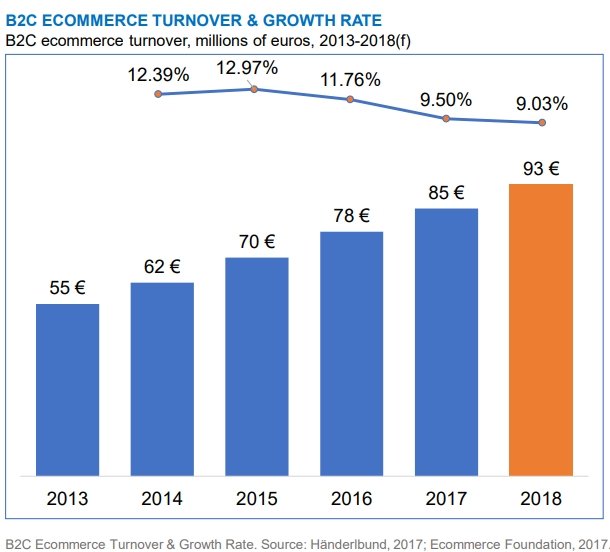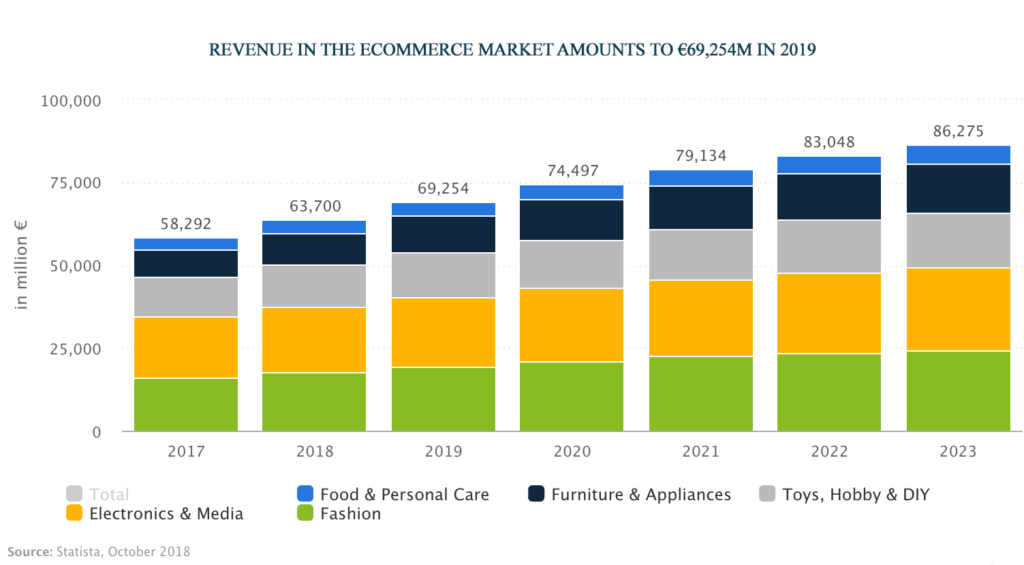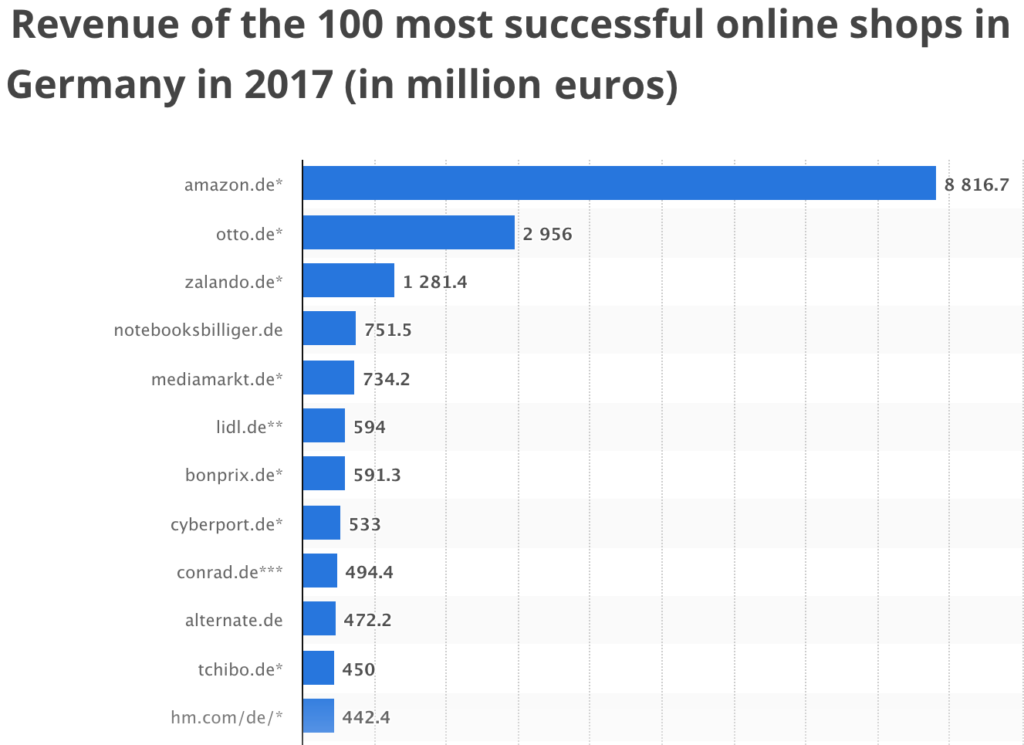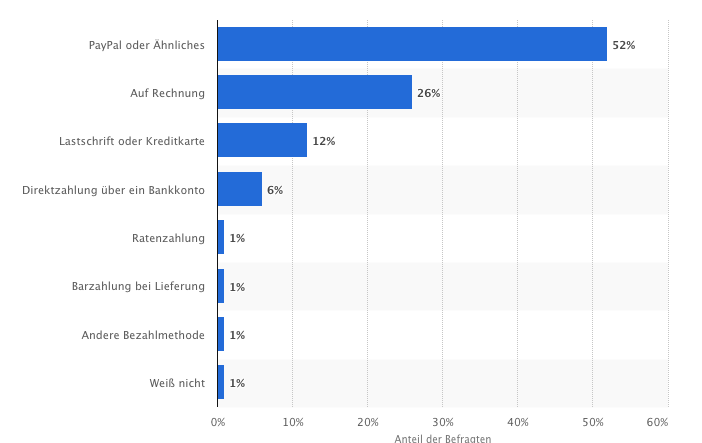The German eCommerce market has many specificities compared to other markets.
Between the different opportunities that it offers, as well as the habits of German consumers, without forgetting the different payment methods etc… I will take the time to develop in this article, all these different specificities.
CONTENT:
- 1 The eCommerce opportunity in Germany
- 2 Top German Marketplaces to sell on
- 3 Online buyers behaviour
- 3.1 German online shoppers
- 4 Payment methods preffered by eCommerce buyers in Germany
- 5 Cross-border shopping
- 6 Logistics, delivery & shipping
- 7 Be mobile ready!
- 8 Is it easy to sell in Germany?
- 9 How to sell online in Germany
- 10 Benefits of selling your products online in Germany
The eCommerce opportunity in Germany
Germany is Europe’s largest economy and the fastest growing e-Commerce market in Western Europe. To give you an idea about revenue numbers: The total E-commerce market size in Germany generated €81.7 billion in 2017 (a growth of more than 9,5 percent compared to the situation in 2016)1

With 68 million people (84% of the German population) online on a regular basis, the german e-commerce market is responsible for around one quarter of all European B2C e-commerce turnover.
(source: https://www.gtai.de/GTAI/Navigation/EN/Invest/Industries/Digital-economy/e-commerce.html?view=renderPdf)
The market’s largest segment is Electronics & Media with a market volume of €21,172m in 2019. A lot of other industries play also an important role and is constantly increasing (such as the Fashion industry. The diagram below shows the revenue by sector in the german eCommerce market in 2019.

Top German Marketplaces to sell on
Amazon, Otto & Zalando
These three companies account for about 44% of total sales from the top 100 ecommerce players in Germany which represents a total value of almost 12 billion euros.
With 8,1 billion euros worth of online sales in Germany (last year), Amazon takes the lead, followed by Otto (2,7 billion euros) and Zalando (1.1 billion euros).
(source: https://ecommercenews.eu/amazon-otto-zalando-dominate-ecommerce-germany/).
It’s no coincidence that the top 3 of online stores also act as a platform or market place, because their large customer base gives them a competitive advantage.

Source: https://www.statista.com/statistics/450288/leading-100-online-shops-by-revenue-germany/
Of course, other actors play an important role, such as: Notebooksbilliger.de, Mediamarkt.de, lidl.de, bonprix.de, cyberport.de etc. (see the diagram above)
Online Buyer behaviour
German online shoppers
Germany’s population exists of 80.8 million people, of which 89% uses the internet. 51.6 million of these internet users shop online.
On average, online shoppers in Germany spent 1,515 euros at ecommerce websites in 2017.
Online shopping is widespread in Germany – and not just among younger members of the population.
According to surveys, 85% of internet users aged between 25 and 44 years had shopped online within the past three months in Germany in 2017.
(source: https://www.statista.com/statistics/506181/e-commerce-online-shoppers-by-age-group-germany/)
When it comes to making online purchases, Germans are careful, detail-oriented and need more time and information before buying something online.
They like to buy books / movies / music and games (47%), clothing (43%) and consumer electronics (41%).2 These are not high value items. They regularly compare prices across different websites to ensure they are getting the best deal.
German consumers show a strong propensity to compare prices and patronize discount stores (special offers). For consumer durables, the criteria are, in order: safety and quality, prestige, comfort, convenience and price. For everyday goods, the determining factor is price.
Demanding buyers
Research also shows that 70% of German shoppers always do some of their research online before they make an important purchase. So it’s essential to have a strong branding, a well-developed marketing strategy during a brand / product launch for example, a deep knowledge of the market, of the rules and of the consumer habits.
Product descriptions translated into German, specific labelling requirements (for certain products, such as foodstuffs and textile), information about shipping, terms and conditions, a fast and optimized site are highly appreciated criteria.
Payment methods prefered by eCommerce buyers in Germany
German buyers are reluctant to buy online! Because of this, it’s essential to reassure them when there are dealing with a secure payment system.
If you are considering selling online in Germany, it’s important to keep in mind that German consumers generally have specific preferences for online payment methods so it’s worth investing in some market research to get a precise idea of their buying habits.
In Germany, the most popular online payment methods are: PayPal (52%), Invoice (26%), Credit card (12%).

https://www.statista.com/statistics/450288/leading-100-online-shops-by-revenue-germany/
Cross-border shopping
Germany is one of the leading European markets for cross-border trade and the third most active country worldwide both in import and export ecommerce, third to only the US and the UK.
To give you an idea: 53% of German internet users purchased a product from abroad in 2015, which is a good result compared to other European countries. Further, Germany is responsible for 15% of global cross-border sales.
German online merchants mostly sell, in number of cross-border sales, to France (5.9 million), Austria (5.5 million), Italy (5 million), Spain (3.9 million) and the Nordics (3.5 million).
Cross-border ecommerce is offering retailers with a multi-channel strategy huge business opportunities. German online shoppers mostly buy cross-border, in number of cross-border sales, from the UK (11.1 million), the US (8.6 million, and China (6.2 million).
(source: https://www.thepaypers.com/ecommerce-facts-and-figures/germany/1)
Logistics, delivery & shipping
The German infrastructure is well-developed with a concentrated network of logistic centres. This means that Germany performs best overall in the field of logistics compared to other European countries.
There is a privatized national mail service: Deutsche Post. Its subsidiary, DHL, plays a considerable role in the European shipping landscape. Not to mention other actors like DPD or myHermes.
“Home delivery” is the most popular delivery method in Germany, preferred by 87% of the population. However, German buyers are becoming more and more open to delivery alternatives, such as click & collect and delivery to pickup-up points, which are interesting options to reduce delivery costs.
The three most important delivery factors are delivery cost, a fast delivery process & the ability to select where delivery is to take place.4 Germany is known for its high return percentage. It’s a detail not to be overlooked.
Be mobile ready!
Unfortunately, a large majority of German retail websites are not optimized for mobile browsing. According to studies, only 60% of German mobile users this year will make a purchase using their phone, compared to 80.4% and 76.4% in the US and UK respectively (source: eMarketer).
However, commercial transactions conducted electronically by mobile phone are growing rapidly.
The mobile share of retail ecommerce sales in Germany amounts to 38%. Even though Germany is a bit behind the UK (52%), which ranked first, it’s still one of the leaders in Europe.
Other details to consider, smartphones are much more popular than tablets among mobile shoppers in Germany.
 [/vc_column_text][/vc_column][/vc_row]
[/vc_column_text][/vc_column][/vc_row]
Is it easy to sell in Germany?
As mentioned earlier, German shoppers are very demanding. Perhaps unsurprisingly, Germany has the highest returns rate in Europe. As high as 70% for fashion retail and around 5-10% for electronics goods.
Online shopping also has its downsides. Delayed deliveries, damaged goods and even items supplied by mistake are not uncommon. Not to mention the language barrier: since German is spoken by 95% of the local population, some sellers can see this factor as an obstacle.
In addition, according to some studies, six out of ten consumers have had a negative experience. All these elements confirm the idea that it is not easy to sell in Germany. Many criteria must be taken into account before implementing itself on the German market.
But given the opportunities offered by the market, it is worthwhile to put in place strategies to establish a business there.
How to sell online in Germany
Selling on the German eCommerce market is a great option to grow your online business. Whether through an eCommerce website or via one of the top eCommerce sites/ platforms like Amazon, Otto, Zalando etc…
It’s not necessary to have an entity located in Germany to sell there.
From a legal point of view, Germany is a member of European Union, therefore it’s essential to be aware of the European Union’s directives as well as German national law.
It is also possible to use a local distributor who has knowledge of the market. The most appropriate strategy depends on many criteria that should be considered one by one before launching.
Benefits of selling your products online in Germany
Located in the heart of Europe, Germany belongs to the strongest economies in the world. The country offers, undoubtedly, real opportunities for international eCommerce sellers (high purchasing volume, logistics-friendly infrastructure…).
The maturity of the German ecommerce market means more competition, but also more predictability as well as popularity of online shopping. All this means that setting up and localizing an online store on the German marketplace may bring, for sure, a lot of extra revenue.
There is no doubt, the E-commerce will continue to grow and will play an important part in the future for a lot of different online actors. There are more and more specialized online retailers, focused on specific categories, which sell through online marketplaces.
It is therefore essential not to neglect Germany. The country plays a fundamental role in the e-commerce landscape, offering plenty of opportunities for a variety of actors wishing to set up.
SOURCES:
1, 2 & 3: Source: https://ecommercenews.eu/ecommerce-in-germany-was-worth-e85-billion-in-2017/
4:https://www.postnord.fi/siteassets/raportit/e-commerce-in-europe-2017_en_low.pdf

